Optimizing the Mechanical Properties of Ultra-High-Performance Fibre-Reinforced Concrete to Increase Its Resistance to Projectile Impact
Abstract
:1. Introduction
2. Experimental Program
2.1. Mix Design
- Portland Cement CEM I strength with a Clinker content of 95% and strength category 52.5R;
- Microsilica with a silica content (SiO2) 97%;
- Polycarboxylate polymer-based superplasticizer;
- Calcareous sand from a local quarry, grading 125–250 μm and 250–500 μm;
- Steel fibres with 0.16 mm diameter and 6 mm or/ and 13 mm length. Density of 7850 kg/m3 and tensile strength of 3000 MPa.
2.2. Specimens and Curing
2.3. Experimental Tests
2.3.1. Uniaxial Compression Test
2.3.2. Direct and Indirect Tension Test
3. Results and Discussion
3.1. Mechanical Properties
- Increased by 25.6% when long fibres 2% (2(0-2)/16/6.1) by volume were included in mixture 0/16/6.1.
- Decreased, when the w/b ratio increased from 0.16 to 0.20, by 15.8% in mixtures without fibres (0/16/6.1 vs. 0/20/6.1) and by 18.0% in mixtures with 2% by volume of fibres (2(0-2)/16/6.1 vs. 2(2-0)/20/6.1).
- Increased by 13.4% when fibres increased from 2% (2(0-2)/16/6.1) to 6% (5-1) ratio 5:1 of 6 mm short fibres to 13 mm long (6(5-1)/16/6.1).
- Increased by 6.2% when in mixture 6(5-1)/16/6.1, with 6% (5-1) by volume of fibres equal amount of short and long fibres (3% by volume, respectively) was placed (6(3-3)/16/6.1).
- Increased by 7.8% when the superplasticizer per binder increased from 0.045 to 0.061 in mixtures with 6% (5-1) by volume of fibres (6(5-1)/16/4.5 vs. 6(5-1)/16/6.1).
- Increased by 109.0% when long fibres 2% (2(0-2)/16/6.1) by volume included in mixture 0/16/6.1 and 70.3% when long fibres 2% (2(0-2)/20/6.1) by volume were included in mixture 0/20/6.1.
- Decreased when w/b increased from 0.16 to 0.20 by 15.9% for mixtures without fibres (0/16/6.1) vs. 0/20/6.1) and 31.5% at mixtures with 2% by volume (2(0-2)/16/6.1 vs. 2(0-2)/20/6.1).
- Exhibited a slight increase of 3.6% when fibres increased in mixture 2(0-2)/16/6.1 from 2% (0-2) to 6% (5-1) fibres by volume (6(5-1)/16/6.1).
- Decreased by 31.6% in beam specimens, when in mixture 6(3-3)/16/6.1 with 6% by volume of fibres equal amount of short and long fibres (3% by volume, respectively) rather than mixture 6(5-1)/16/6.1 with 6% and 5% short fibres and 1% long fibres. Increased by 11.6% when bone specimens were used for mixture 6(3-3)/16/6.1 compared to mixture 6(5-1)/16/6.1.
- Showed a significant increase of 100% when 2% (2(0-2)/16/6.1) by volume fibres included in mixture 0/16/6.1 and 280% when fibres 2% (2(0-2)/20/6.1) by volume were included in mixture 0/20/6.1.
- Increased by 73.7% in mixtures without fibres (0/16/6.1 vs. 0/20/6.1) and minor decreased from 29.0 to 26.6 MPa (8.3%) in mixtures with 2% by volume of fibres (2(0-2)/16/6.1 vs. 2(0-2)/20/6.1), when the w/b ratio decreased from 0.20 to 0.16.
- Increased by 19.2% when fibres increased in mixture 2(0–2)/16/6.1 from 2% (0–2) to 6% (5-1) (6(5-1)/16/6.1). When equal numbers of short and long fibres (3% by volume) were placed in mixture with 6% by volume of fibres (6(3-3)/16/6.1), it remained almost the same (slight improvement of 5%) as 6(5-1)/16/6.1.
3.2. Full Stress–Strain Curves from Uniaxial Compression Tests and Parametric Investigation
3.3. Full Stress–Strain Curves from Direct Tension Tests and Parametric Investigation
4. Finite Element Modelling of UHPFRC Mixture 6(3-3)/16/6.1
5. Conclusions
- When the ratio of small to long steel fibres was altered to 3:3 rather than 5:1, the compressive strength of cubic specimens showed a slight improvement of 6.2% and the ductility increased with a large deformation developing in the plastic region.
- When the number of steel fibres increased from 2(0-2) to 6(5-1) by volume, the compression and direct and flexural tension increased by 13.4%, 3.6%, and 19.2%, respectively. Fibres’ increase contributed significantly to the increase in ultimate strain in compression from 4.3 × 10−3 to 5.6 × 10−3.
- The addition of 2% by volume steel fibres to the mixture increased by 25.6% and 23.3% the compressive strength for w/b 0.16 and 0.20, respectively, and the direct tensile strength by 70.0% for w/b 0.20% and 109.0% for w/b 0.16. The flexural strength exhibited the highest increase of 280.0% for w/b equal to 0.2% and 102.0% for w/b 0.16.
- The modulus of elasticity measured in compression testing was around 40 GPa. This is lower than expected for UHPFRC, which is attributed to the properties of the local materials.
- Poisson’s ratio, with an average of 0.25, was higher than the expected values for normal concrete, between 0.15 and 0.20.
- The cubic to cylindrical strength ratio was 0.88 for cubic specimens with a side length of 100 mm and cylindrical specimens with a diameter of 100 mm and height of 200 mm.
- The increase in the superplasticizer to binder ratio, from 4.5% to 6.1%, in mixture 6(5-1), helped in achieving a uniform distribution of fibres, due to the improved workability, and significantly improving the ductility in compression.
- Small specimens (dogbones) achieved a rather 2D orientation of the fibres, which contributed to the development of strain hardening behaviour during direct tension tests and increased the direct tensile strength from 6.5 to 10.6 MPa for mixture 6(3-3).
- A numerical simulation was developed using the CDP model in ABAQUS, which was cable of capturing the experimental three-point bending response of the UHPFRC 6(3-3) mixture.
Author Contributions
Funding
Data Availability Statement
Acknowledgments
Conflicts of Interest
References
- Shi, C.; Wang, D.; Wu, L.; Wu, Z. The hydration and microstructure of ultra high-strenght concrete with cement-silica fume-slag binder. Cem. Concr. Compos. 2015, 61, 44–52. [Google Scholar] [CrossRef]
- Wang, C.; Yang, C.; Liu, F.; Wan, C.; Pu, X. Preparation of Ultra-High Performance Concrete with common technology and materials. Cem. Concr. Compos. 2012, 34, 538–544. [Google Scholar] [CrossRef]
- Lura, P.; Breugel, K.V.; Maruyama, I. Effect of curing temperature and type of cement on early-age shrinkage of high-performance concrete. Cem. Concr. Res. 2001, 31, 1867–1872. [Google Scholar] [CrossRef]
- Zhang, Y.; Sun, W.; Liu, S. Study on the hydration heat of binder paste in high-performance concrete. Cem. Concr. Res. 2002, 32, 1483–1488. [Google Scholar] [CrossRef]
- Richard, P.; Cheyrezy, M. Composition of reactive power concretes. Cem. Concr. Res. 1995, 25, 1501–1511. [Google Scholar] [CrossRef]
- Schmidt, M.; Fehling, E. Ultra-high-performance concrete: Research, development and application in Europe. In Seventh International Symposium on the Utilization of High-Strenght and High-Performance Concrete; ACI: Washington, DC, USA, 2005; pp. 51–78. [Google Scholar]
- Rokugo, K.; Kanda, T.; Yokota, H.; Sakata, N. Applications and recommendations of high performance fiber reinforced cement composites with multiple fine cracking (HPFRCC) in Japan. Mater. Struct. 2009, 42, 1197–1208. [Google Scholar] [CrossRef]
- Yoo, D.-Y.; Yoon, Y.-S. A Review on Structural Behavior, Design, and Application of Ultra-High-Performance Fiber-Reinforced Concrete. Int. J. Concr. Struct. Mater. 2016, 10, 125–142. [Google Scholar] [CrossRef] [Green Version]
- Alkaysi, M.; El-Tawil, S.; Liu, Z.; Hansen, W. Effects of silica powder and cement type on durability of ultra high performance concrete (UHPC). Cem. Concr. Compos. 2016, 66, 47–56. [Google Scholar] [CrossRef]
- Yu, R.; Spiesz, P.; Brouwers, H.J.H. Mix design and properties assessment of Ultra-High Performance Fibre Reinforced Concrete (UHPFRC). Cem. Concr. Res. 2014, 56, 29–39. [Google Scholar] [CrossRef]
- Kazemi, S.; Lubell, A.S. Influence of specimen size and fiber content on mechanical properties of ultra-high-performance fiber-reinforced concrete. ACI Mater. J. 2012, 109, 675–684. [Google Scholar]
- Yu, R.; Spiesz, P.; Brouwers, H.J. Development of ultra-high performance fibre reinforced concrete (UHPFRC): Towards an efficient utilization of binders and fibres. Constr. Build. Mater. 2015, 79, 273–282. [Google Scholar] [CrossRef] [Green Version]
- Nicolaides, D.; Kanellopoulos, A.; Petrou, M.; Savva, P.; Mina, A. Development of a new ultra high performance fibre reinforced cementitious composite (UHPFRCC) for impact and blast protection of structures. Constr. Build. Mater. 2015, 95, 667–674. [Google Scholar] [CrossRef]
- Mina, A.L.; Petrou, M.F.; Trezos, K.G. Experimental analysis for the development of an UHPFRC. In Proceedings of the Concrete Solutions 2016, 6th International Conference on Concrete Repair, Thessaloniki, Greece, 20–23 June 2016. [Google Scholar]
- Kim, M.-J.; Yoo, D.-Y.; Kim, S.; Shin, M.; Banthia, N. Effects of fiber geometry and cryogenic condition on mechanical properties of ultra-high-performance fiber-reinforced concrete. Cem. Concr. Res. 2018, 107, 30–40. [Google Scholar] [CrossRef]
- Spyridon, P.; Lampropoulos, A. Fiber content and curing time effect on the tensile characteristics of ultra high performance fiber reinforced concrete. Struct. Concr. 2017, 18, 577–588. [Google Scholar]
- Máca, P.; Sovják, R.; Vavřiník, T. Experimental Investigation of Mechanical Properties of UHPFRC. Procedia Eng. 2013, 65, 14–19. [Google Scholar] [CrossRef] [Green Version]
- Graybeal, B.A.; Baby, F. Development of direct tension test method for ultra-high-performance fiber reinforced concrete. ACI Mater. J. 2013, 110, 177–186. [Google Scholar]
- Wille, K.; El-Tawil, S.; Naaman, A. Properties of strain hardening ultra high performance fiber reinforced concrete (UHP-FRC) under direct tensile loading. Cem. Concr. Compos. 2014, 48, 53–66. [Google Scholar] [CrossRef]
- Pyo, S.; Wille, K.; El-Tawil, S.; Naaman, A.E. Strain rate dependent properties of ultra high performance fiber reinforced concrete (UHP-FRC) under tension. Cem. Concr. Compos. 2015, 56, 15–24. [Google Scholar] [CrossRef]
- Yoo, D.-Y.; Kim, S.; Kim, J.-J.; Chun, B. An experimental study on pullout and tensile behavior of ultra-high-performance concrete reinforced with various steel fibers. Constr. Build. Mater. 2019, 206, 46–61. [Google Scholar] [CrossRef]
- Hassan, A.; Jones, S.W.; Mahmud, G. Experimental test methods to determine the uniaxial tensile and compressive behaviour of ultra high performance fibre reinforced concrete (UHPFRC). Constr. Build. Mater. 2012, 37, 874–882. [Google Scholar] [CrossRef]
- Nicolaides, D.; Kanellopoulos, A.; Savva, P.; Petrou, M. Experimental field investigation of impact and blast load resistance of ultra high performance fibre reinforced cementitious composites (UHPFRCCs). Constr. Build. Mater. 2015, 95, 566–574. [Google Scholar] [CrossRef]
- Clifton, J.R.; Knab, L.I. Impact testing of concrete. Concr. Cem. Res. 1983, 13, 541–548. [Google Scholar] [CrossRef]
- Zhang, M.H.; Shim, V.P.; Lu, G.; Chew, C.W. Resistance of high-strength concrete to projectile impact. Int. J. Impact Eng. 2005, 31, 825–841. [Google Scholar] [CrossRef]
- O’Neil, E.F.; Neeley, B.D.; Cargile, J.D. Tensile properties of very-high-strength concrete for penetration-resistant structures. Shock Vib. 1999, 6, 237–245. [Google Scholar] [CrossRef] [Green Version]
- Sovják, R.; Máca, P.; Imlauf, T. Effect of fibre aspect ratio and fibre volume fraction on the effective fracture energy of ultra-high-performance fibre-reinforced concrete. Acta Polytech. 2016, 56, 319–327. [Google Scholar] [CrossRef]
- Sovják, R.; Máca, P.; Imlauf, T. Effect of fibre length on the fracture energy of UHPFRC. Procedia Eng. 2017, 193, 74–79. [Google Scholar] [CrossRef]
- Máca, P.; Sovják, R.; Konvalinka, P. Mix design of UHPFRC and its response to projectile impact. Int. J. Impact Eng. 2014, 63, 158–163. [Google Scholar] [CrossRef]
- Kravanja, S.; Sovják, R. Ultra-high-performance Fibrereinforced concrete under high-velocity projectile impact. Part I. Experiments. Acta Polytech. 2018, 58, 232–239. [Google Scholar] [CrossRef]
- Benson, S.D.P.; Karihaloo, B.L. CARDIFRC—Development and mechanical properties. Part I: Development and workability. Mag. Concr. Res. 2005, 57, 347–352. [Google Scholar] [CrossRef] [Green Version]
- CYS EN 12390-1. Testing Hardened Concrete—Part 1. Shape, Dimensions and other Requirements for Specimens and Moulds; Cyprus Organization for Standardization: Nicosia, Cyprus, 2009. [Google Scholar]
- CYS EN 12390-3. Testing Hardened Concrete—Part 3: Compressive Strength of Test Specimens; Cyprus Organization for Standardization: Nicosia, Cyprus, 2009. [Google Scholar]
- ASTM C617-98. Standard Practice for Capping Cylindrical Concrete Specimens; ASTM International: West Conshohocken, PA, USA, 2003. [Google Scholar]
- Kolias, S.; Williams, R. Uniaxial Tension Tests on Cement-Stabilized Granular Materials. Geotech. Test J. 1978, 1, 190–198. [Google Scholar]
- Soroushian, P.; Lee, C.-D. Distribution and orientation of fibers in steel fiber reinforced concrete. ACI Mater. J. 1990, 87, 433–439. [Google Scholar]
- CYS EN 12390-5. Testing Hardened Concrete—Part 5: Flexural Strength of Test Specimens; Cyprus Organization for Standardization: Nicosia, Cyprus, 2009. [Google Scholar]
- Abbas, S.; Soliman, A.M.; Nehdi, M.L. Exploring mechanical and durability properties of ultra-high performance concrete incorporating various steel fiber lengths and dosages. Constr. Build. Mater. 2015, 75, 429–441. [Google Scholar] [CrossRef]
- Graybeal, B.; Davis, M. Cylinder or cube: Strength testing of 80 to 200 MPa (11.6 to 29 ksi) ultra-high-performance fiber-reinforced concrete. ACI Mater. J. 2008, 105, 603–609. [Google Scholar]
- Wille, K.; Naaman, A.E. Pullout behavior of high-strength steel fibers embedded in ultra-high-performance concrete. ACI Mater. J. 2012, 109, 479–487. [Google Scholar]
- Zhou, B.; Uchida, Y. Influence of flowability, casting time and formwork geometry on fiber orientation and mechanical properties of UHPFRC. Cem. Concr. Res. 2017, 95, 164–177. [Google Scholar] [CrossRef]
- Mina, A.L.; Petrou, M.F.; Trezos, K.G. Resistance of an optimized Ultra-High Performance Fiber Reinforced Concrete to Projectile Impact. Buildings 2021, 11, 63. [Google Scholar] [CrossRef]
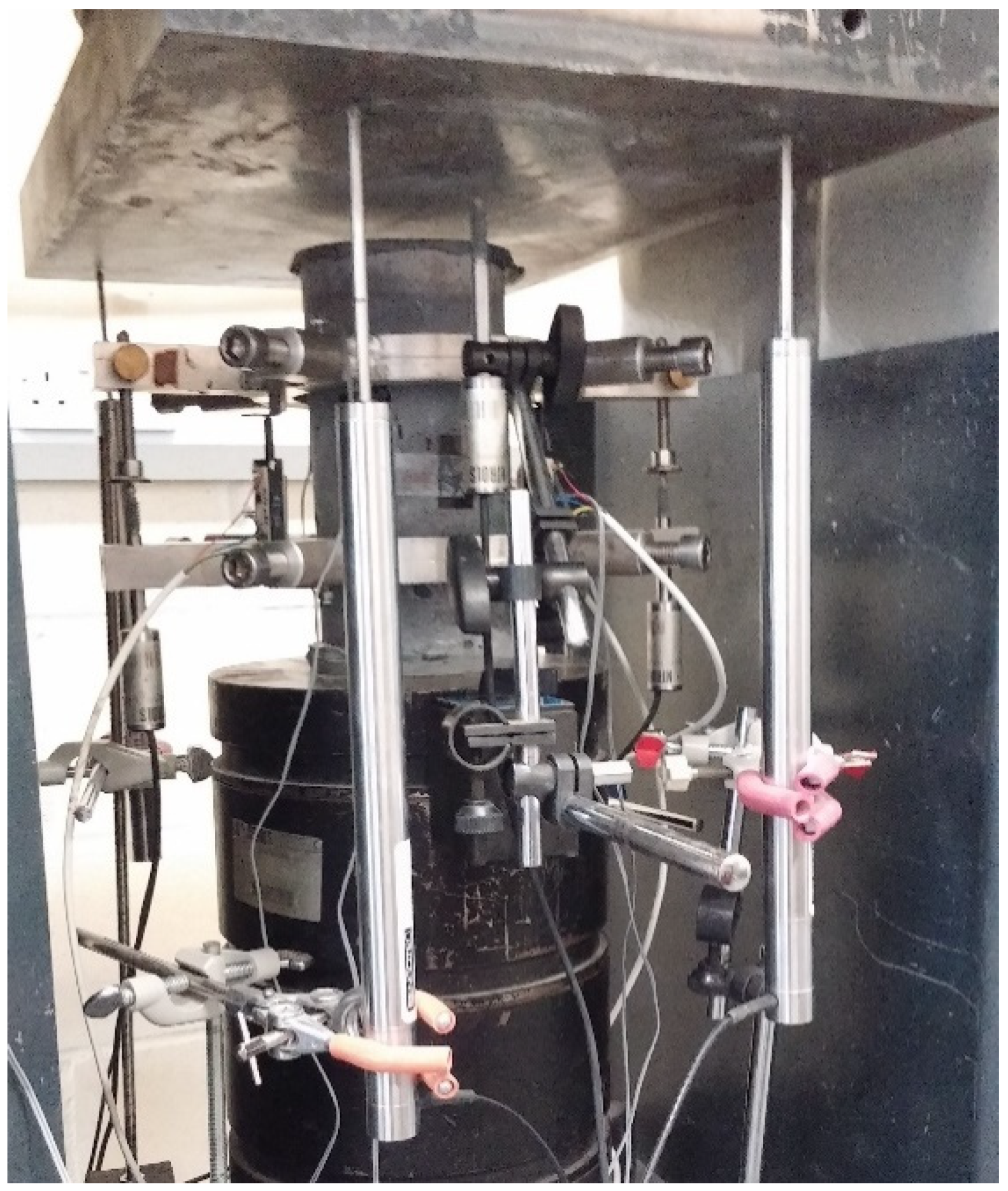

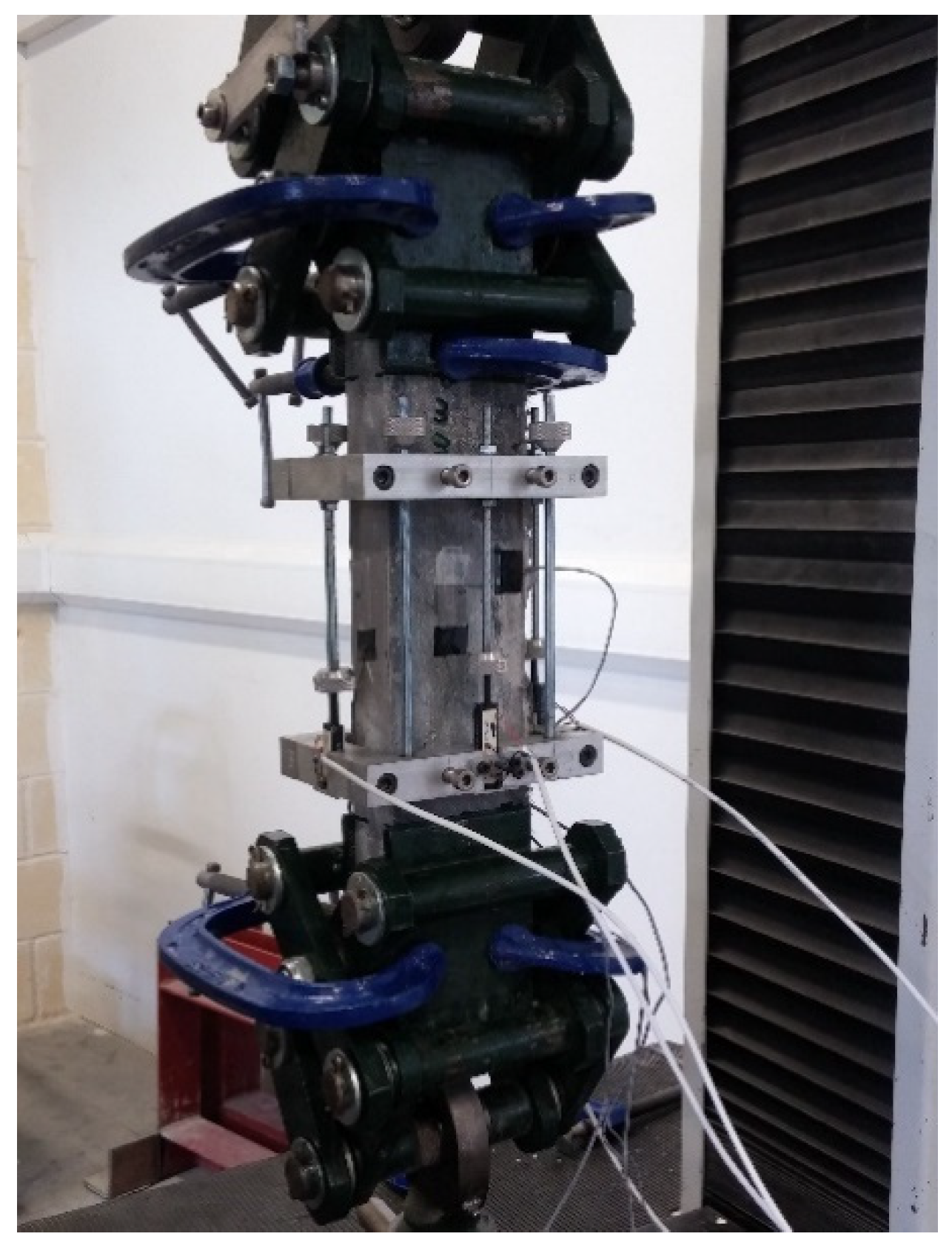
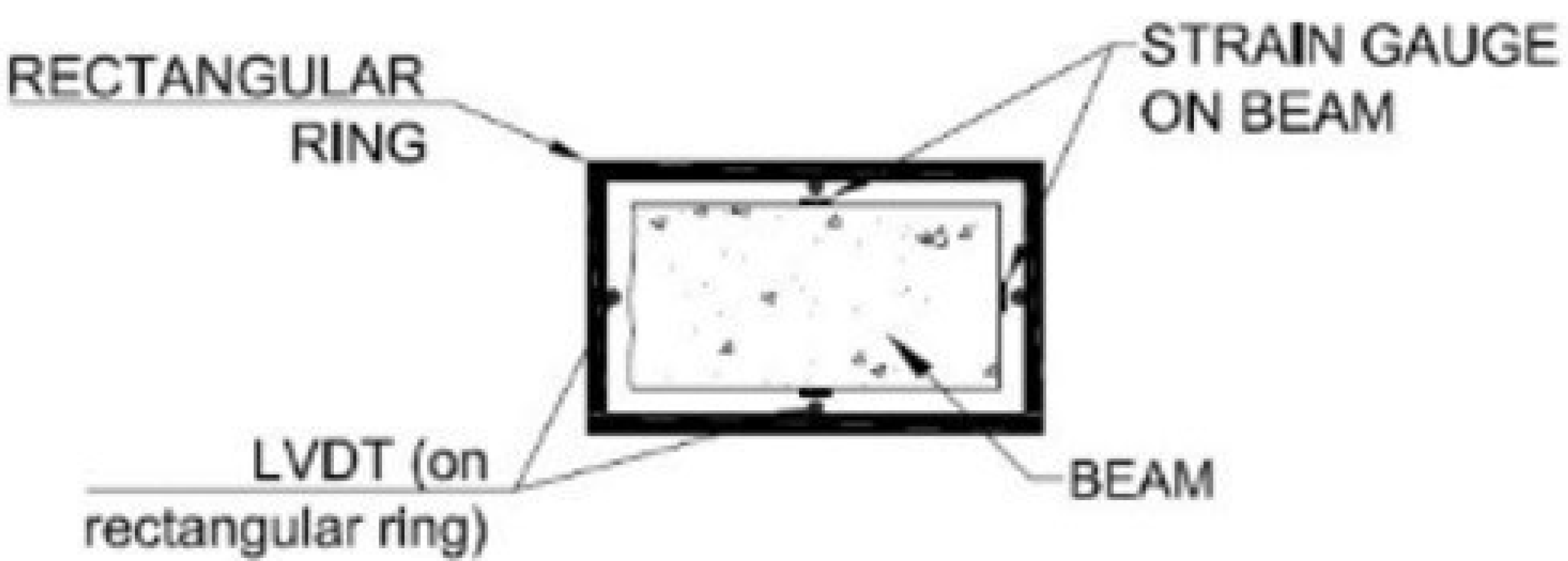
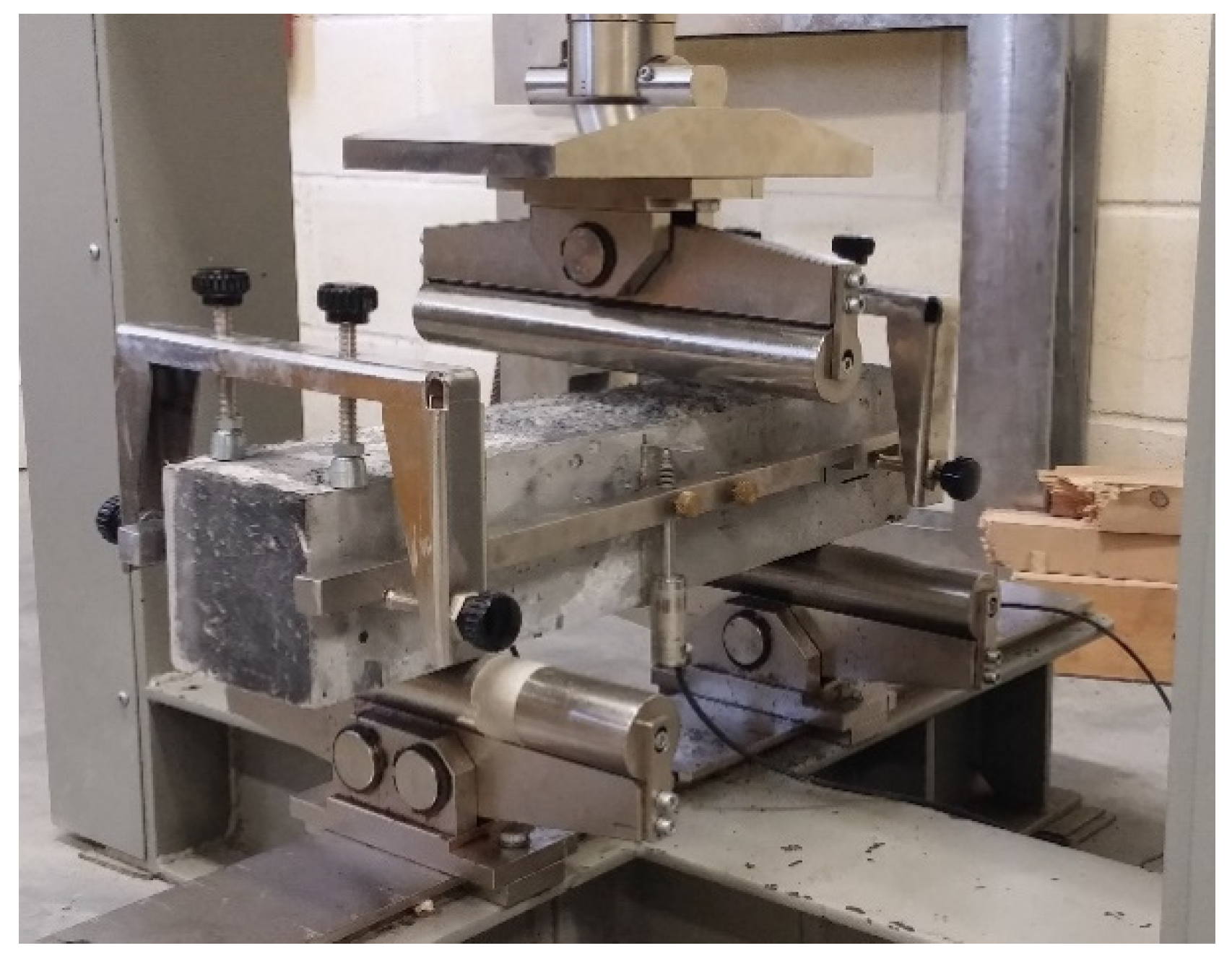

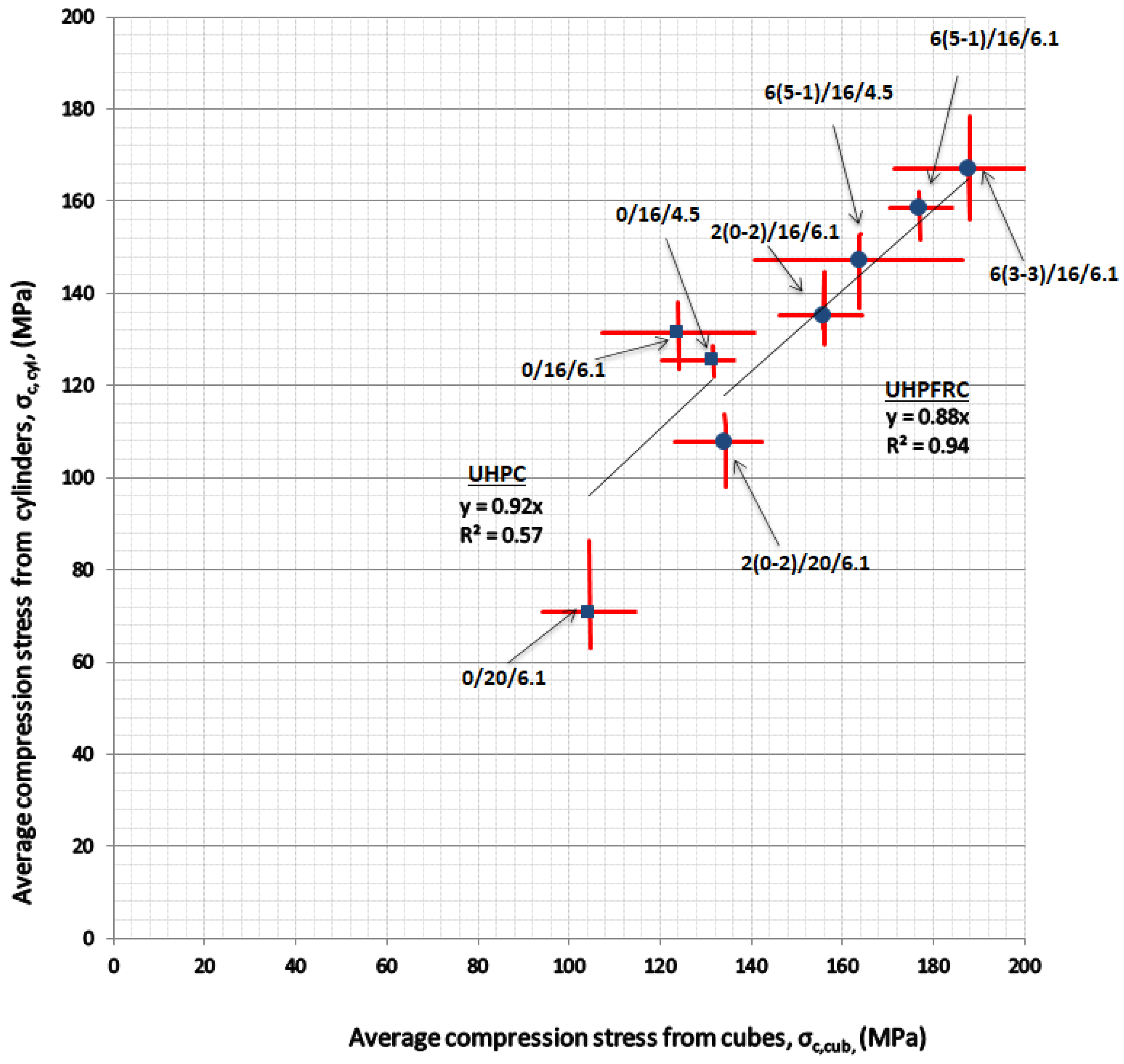

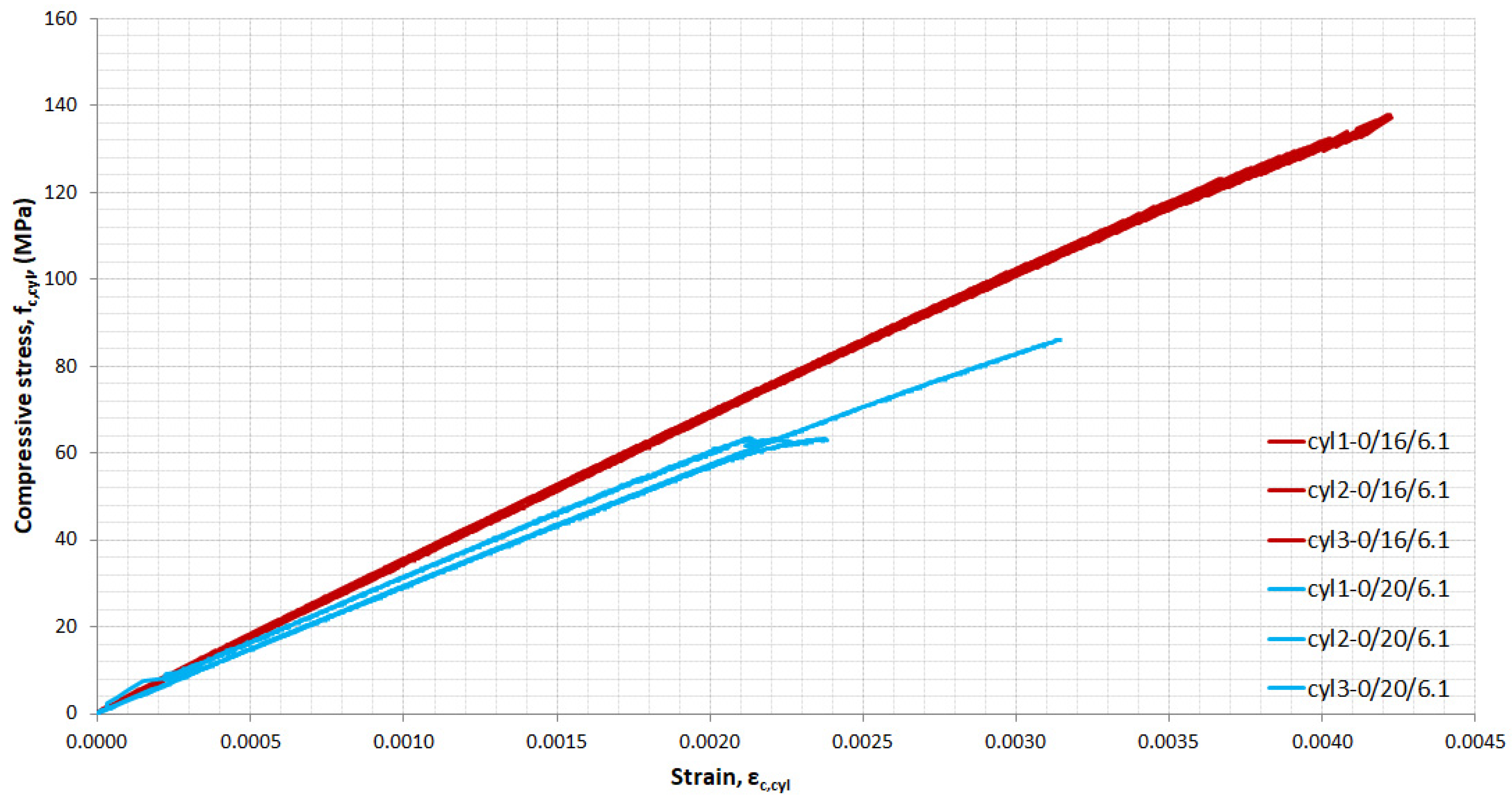

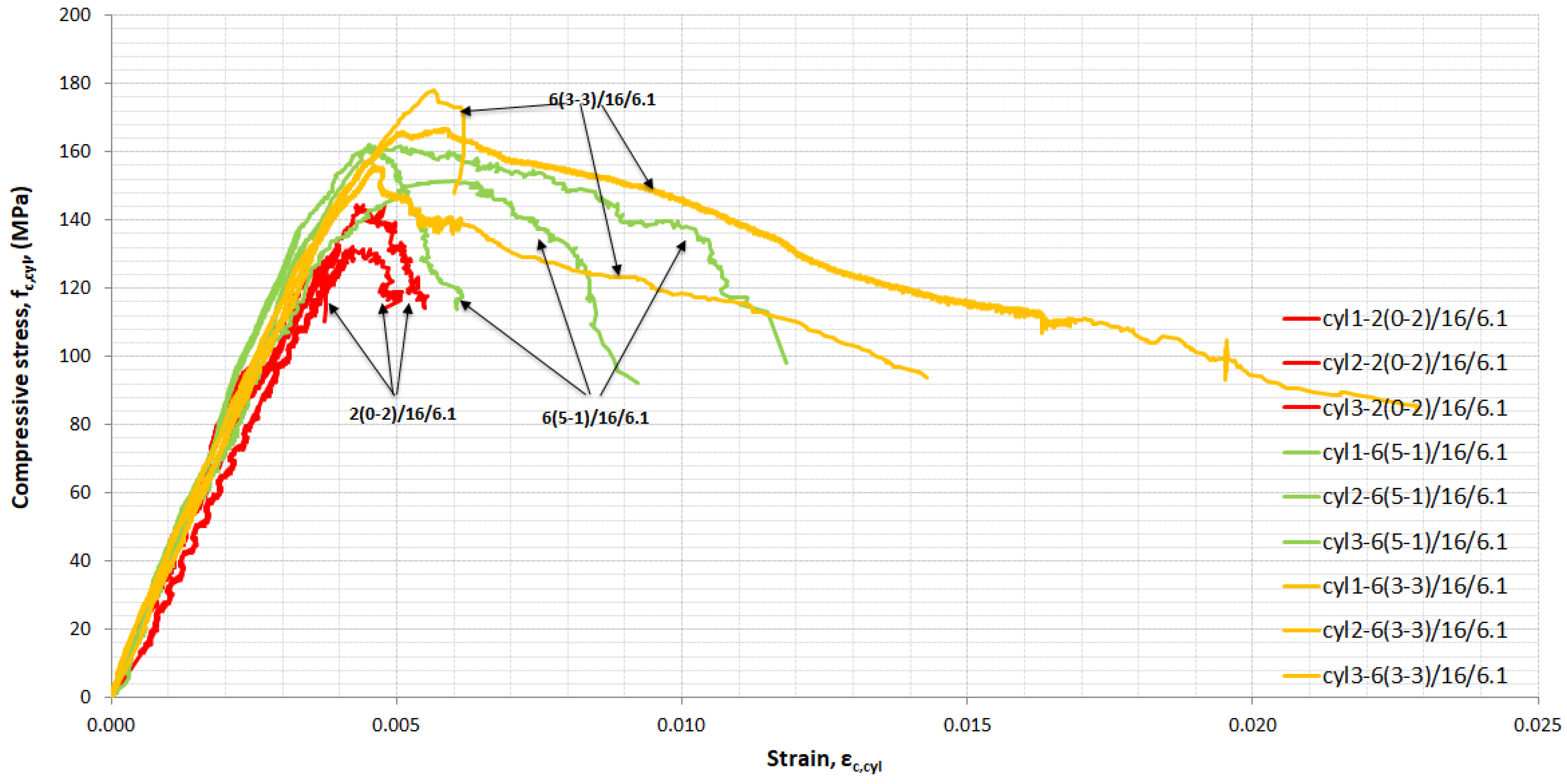

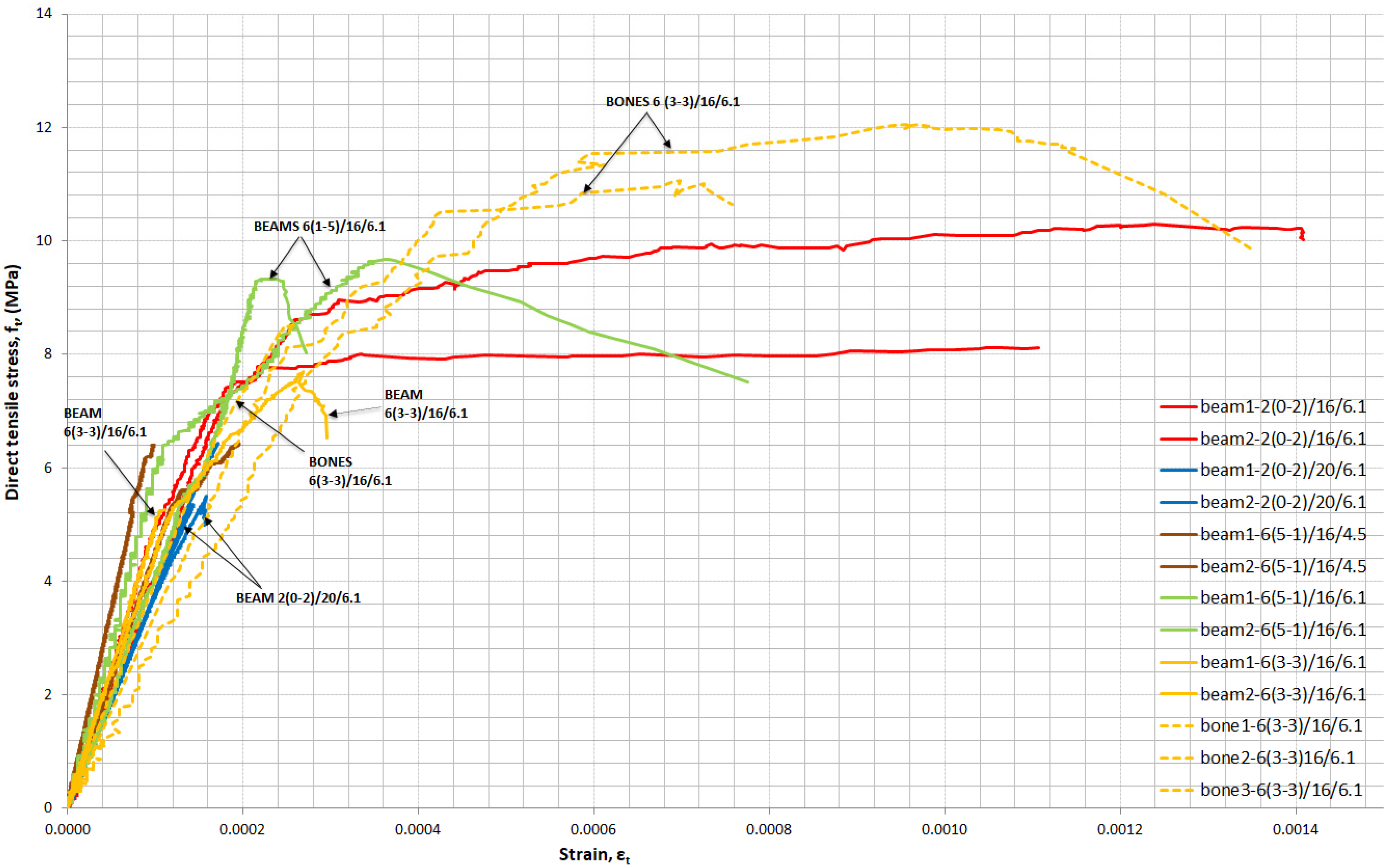
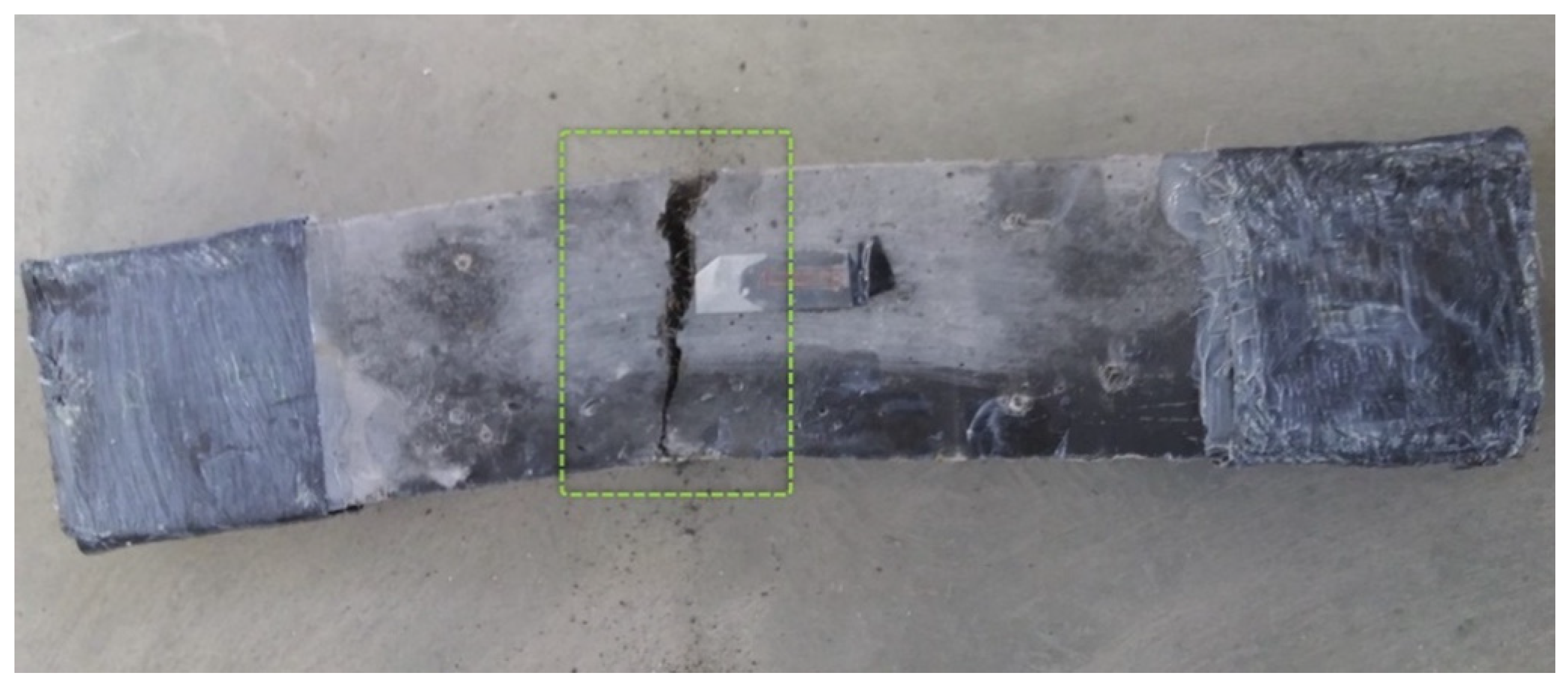
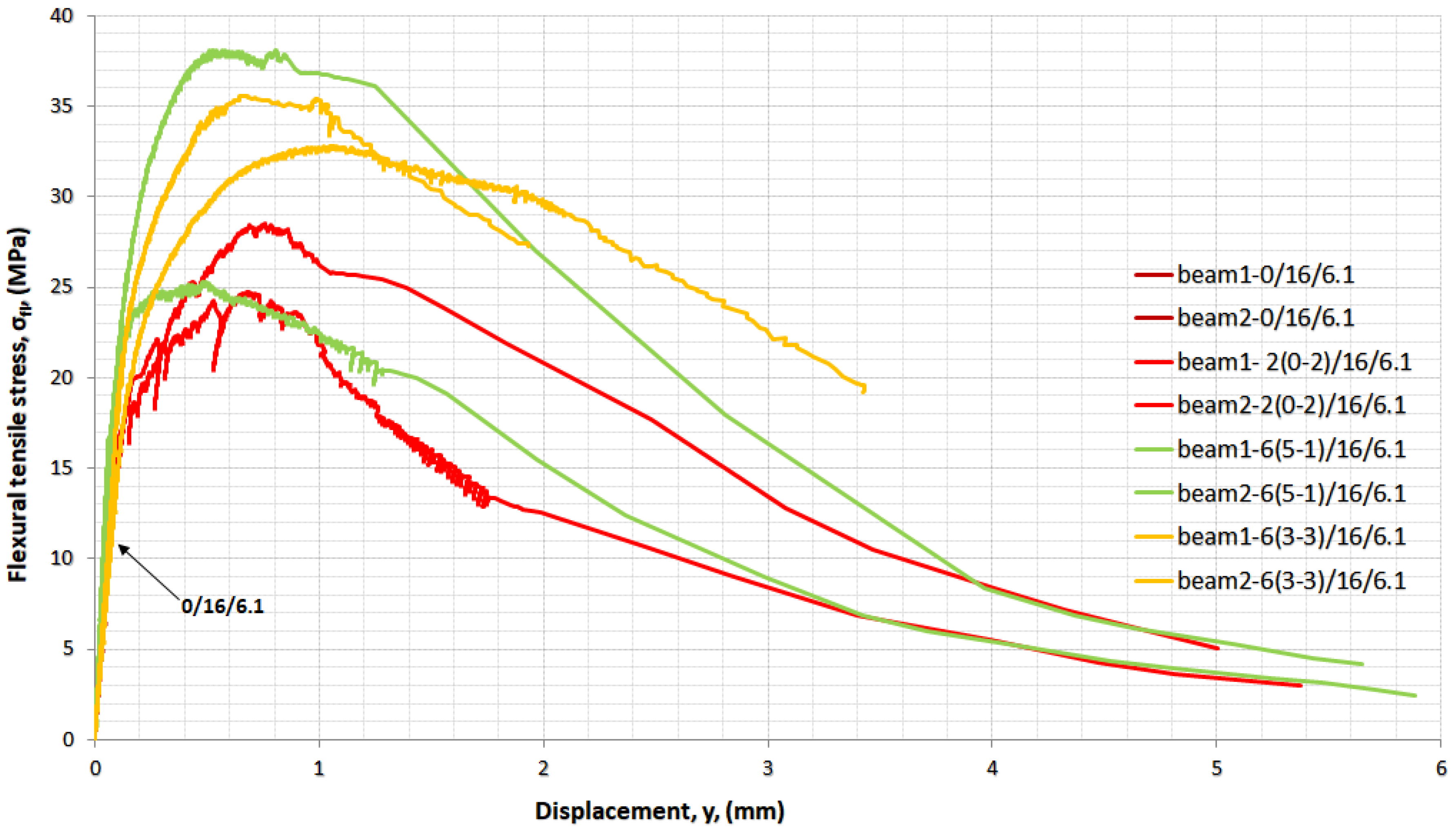
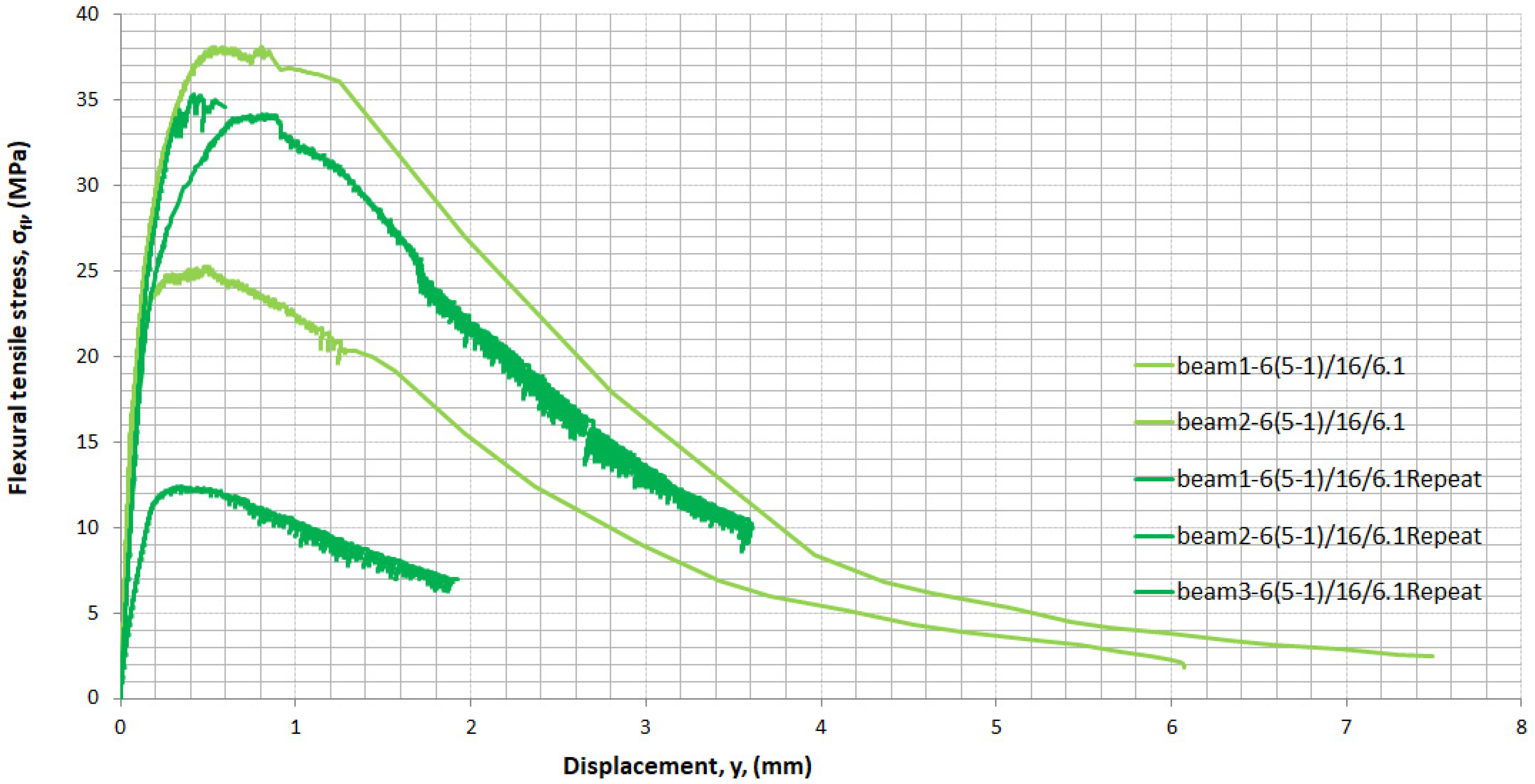
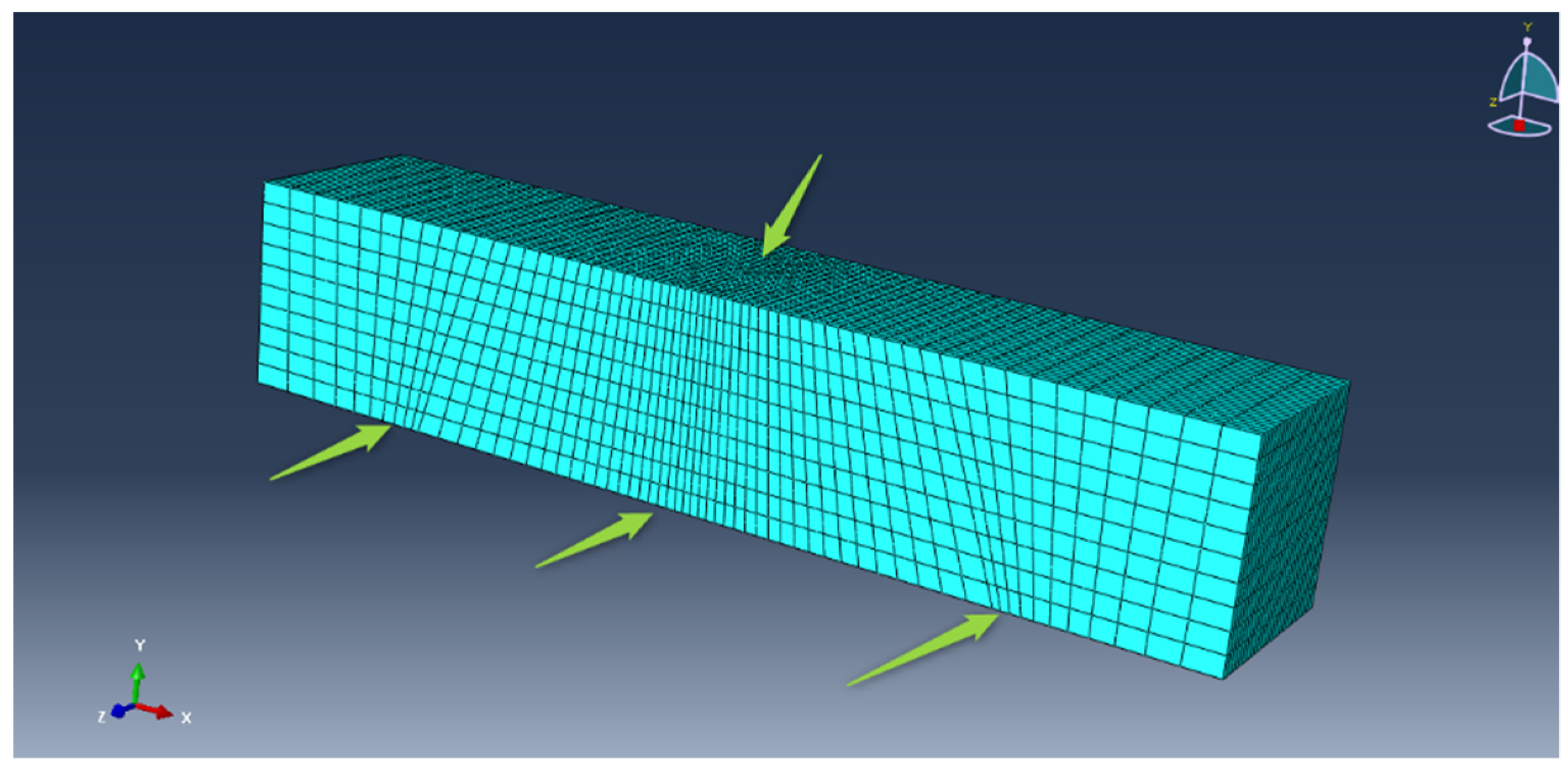


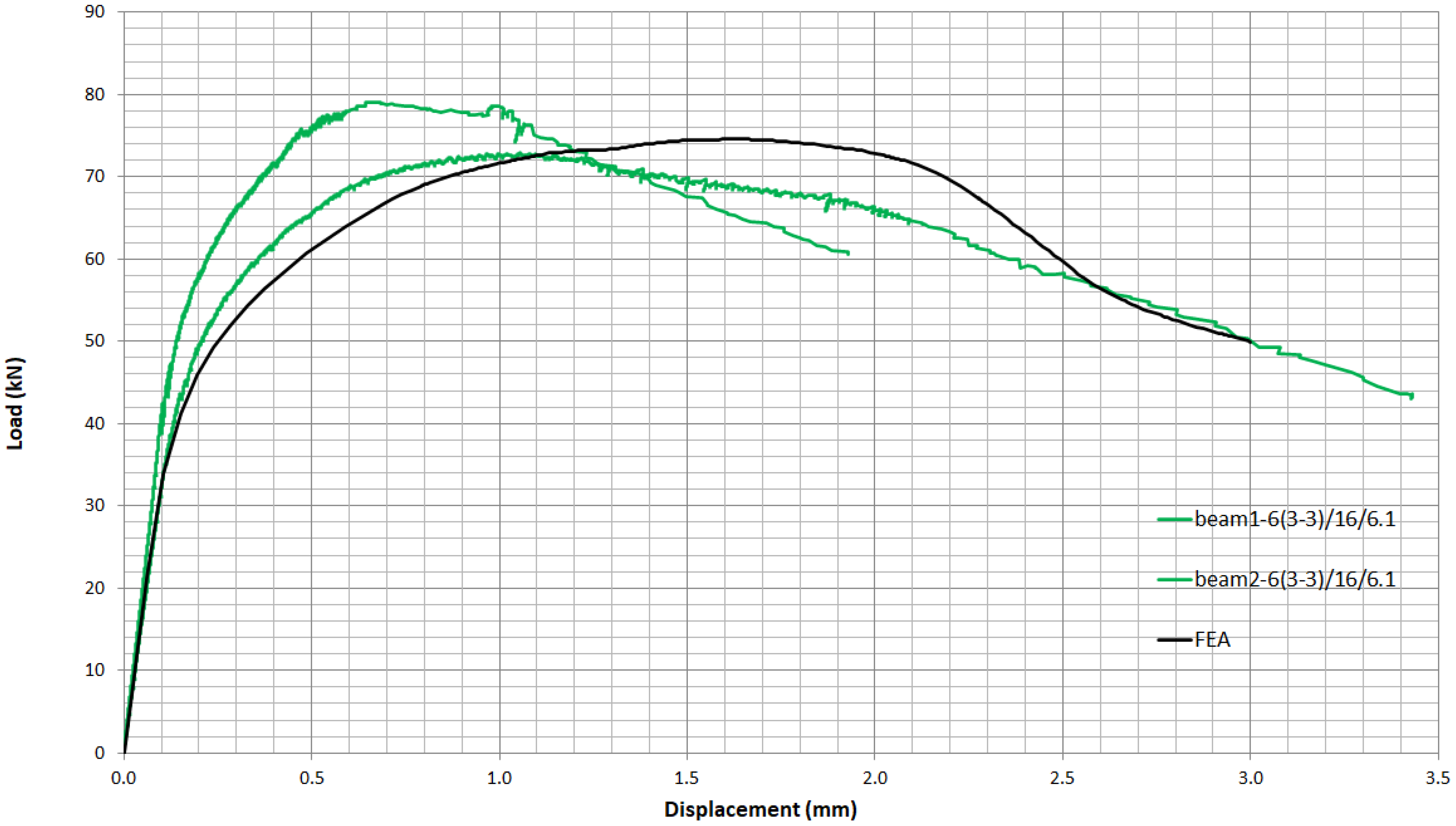
| Materials (kg/m3) | 0/16/4.5 | 0/16/6.1 | 0/20/6.1 |
|---|---|---|---|
| Cement | 880 | 880 | 880 |
| Microsilica | 220 | 220 | 220 |
| Steel fibres 6 mm | 0 | 0 | 0 |
| Steel fibres 13 mm | 0 | 0 | 0 |
| Local sand 125–250 μm | 475 | 475 | 475 |
| Local sand 250–500 μm | 358 | 358 | 358 |
| Water | 176 | 176 | 220 |
| Superplasticizer | 50 | 67 | 67 |
| Materials (kg/m3) | 2(0-2)/16/6.1 | 2(0-2)/20/6.1 | 6(5-1)/16/4.5 | 6(5-1)/16/6.1 | 6(3-3)/16/6.1 |
|---|---|---|---|---|---|
| Cement | 880 | 880 | 880 | 880 | 880 |
| Microsilica | 220 | 220 | 220 | 220 | 220 |
| Steel fibres 6 mm | 0 | 0 | 400 | 400 | 240 |
| Steel fibres 13 mm | 160 | 160 | 80 | 80 | 240 |
| Local sand 125–250 μm | 475 | 475 | 475 | 475 | 475 |
| Local sand 250–500 μm | 358 | 358 | 358 | 358 | 358 |
| Water | 176 | 220 | 176 | 176 | 176 |
| Superplasticizer | 67 | 67 | 50 | 67 | 67 |
| Mix Design. | Number of Specimens | ||||
|---|---|---|---|---|---|
| Cubes (100 mm × 100 mm × 100 mm) | Cylinders (d = 100 mm, h = 200 mm) | Prismatic Beams (100 mm × 50 mm × 500 mm) | Prismatic Beams (100 mm × 100 mm × 500 mm) | Dogbones | |
| 0/16/4.5 | 5 | 2 | 4 | - | - |
| 0/16/6.1 | 6 | 3 | 2 | 2 | - |
| 0/20/6.1 | 4 | 3 | 2 | 2 | - |
| 2(0-2)/16/6.1 | 6 | 3 | 2 | 2 | - |
| 2(0-2)/20/6.1 | 6 | 3 | 2 | 2 | - |
| 6(5-1)/16/4.5 | 5 | 2 | 4 | - | - |
| 6(5-1)/16/6.1 | 6 | 3 | 2 | 3 | - |
| 6(3-3)/16/6.1 | 6 | 3 | 2 | 3 | 3 |
| Cubes (100 mm × 100 mm × 100 mm) | Cylinders (d = 100 mm, h = 200 mm) | Prismatic Beams (100 mm × 50 mm × 500 mm) | Prismatic Beams (100 mm × 100 mm × 500 mm) | Dogbones |
|---|---|---|---|---|
| Compression | Compression | Direct tension | Flexural tension | Direct tension |
| Mix Design | Compression Test | Direct Tension Test | Flexural Tension Test | ||||||
|---|---|---|---|---|---|---|---|---|---|
| Compression Strength from Cubes (MPa) | Compression Strength from Cylinders (MPa) | E (GPa) | ν | Direct Tensile Strength from Beams (MPa) | Direct Tensile Strength from Bones (MPa) | Ε (GPa) | ν | Flexural Tensile Strength from Beams (MPa) | |
| 0/16/4.5 | 131.6 | 125.3 | 34.2 | 0.24 | 4.2 | --- | 35.2 | 0.25 | --- |
| 0/16/6.1 | 124.0 | 131.3 | 33.1 | 0.25 | 4.4 | --- | 35.3 | 0.24 | 13.2 |
| 0/20/6.1 | 104.4 | 70.8 | 28.3 | 0.26 | 3.7 | --- | 34.1 | --- | 7.6 |
| 2(0-2)/16/6.1 | 155.8 | 135.3 | 35.2 | 0.22 | 9.2 | --- | 35.4 | 0.25 | 26.6 |
| 2(0-2)/20/6.1 | 127.7 | 107.6 | 31.0 | 0.26 | 6.3 | --- | 38.2 | 0.27 | 29.0 |
| 6(5-1)/16/4.5 | 163.8 | 147.7 | 41.4 | 0.22 | 6.1 | --- | 47.8 | 0.25 | --- |
| 6(5-1)/16/6.1 | 176.7 | 158.4 | 37.5 | 0.26 | 9.5 | --- | 45.2 | 0.27 | 31.7 |
| 6(3-3)/16/6.1 | 187.6 | 167.1 | 38.6 | 0.25 | 6.5 | 10.6 | 43.5 | 0.24 | 33.3 |
Publisher’s Note: MDPI stays neutral with regard to jurisdictional claims in published maps and institutional affiliations. |
© 2021 by the authors. Licensee MDPI, Basel, Switzerland. This article is an open access article distributed under the terms and conditions of the Creative Commons Attribution (CC BY) license (https://creativecommons.org/licenses/by/4.0/).
Share and Cite
Mina, A.L.; Trezos, K.G.; Petrou, M.F. Optimizing the Mechanical Properties of Ultra-High-Performance Fibre-Reinforced Concrete to Increase Its Resistance to Projectile Impact. Materials 2021, 14, 5098. https://doi.org/10.3390/ma14175098
Mina AL, Trezos KG, Petrou MF. Optimizing the Mechanical Properties of Ultra-High-Performance Fibre-Reinforced Concrete to Increase Its Resistance to Projectile Impact. Materials. 2021; 14(17):5098. https://doi.org/10.3390/ma14175098
Chicago/Turabian StyleMina, Anna L., Konstantinos G. Trezos, and Michael F. Petrou. 2021. "Optimizing the Mechanical Properties of Ultra-High-Performance Fibre-Reinforced Concrete to Increase Its Resistance to Projectile Impact" Materials 14, no. 17: 5098. https://doi.org/10.3390/ma14175098






